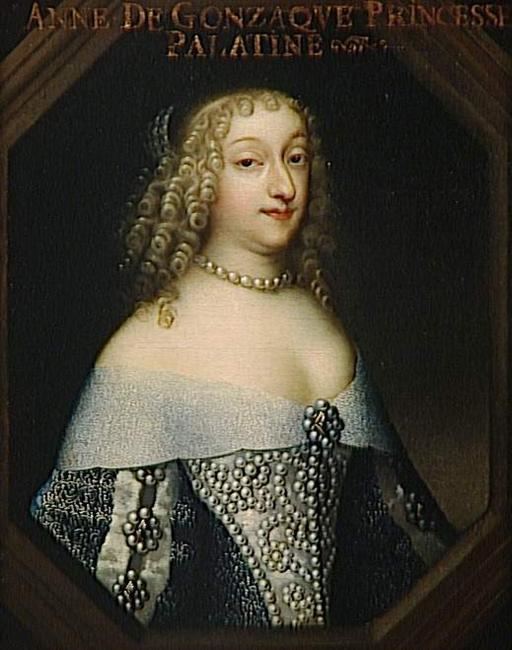Name Anne Gonzaga | ||
 | ||
IssueDetail Louise Marie, Princess of SalmAnne Henriette, Princess of CondeBenedicte, Duchess of Brunswick-Luneburg Mother Catherine de Lorraine-Guise-Mayenne Spouse Edward, Count Palatine of Simmern (m. 1645) Parents Charles Gonzaga, Duke of Mantua and Montferrat Children Anne Henriette of Bavaria, Benedicta Henrietta of the Palatinate, Luise Marie of the Palatinate Similar People Marie Louise Gonzaga, Henriette of Cleves, Louise Benedicte de Bourb, Louis - Prince of Conde, Elizabeth Stuart - Queen of | ||
Anne Gonzaga (Anne Marie; 1616 – 6 July 1684) was an Italian French noblewoman and salonist. The youngest daughter of Charles Gonzaga, Duke of Mantua and Montferrat, and Catherine de Lorraine (herself daughter of Charles, Duke of Mayenne), Anne was "Princess Palatine" as the wife of Edward of the Palatinate, a grandson of King James I of England and uncle to King George I of Great Britain. She bore Edward three children, all daughters. Had Anne not converted Edward to Catholicism, the English throne might have passed to their descendants.
Contents
Family and early life
Anne Marie de Gonzague (-Nevers) was born in Paris into a cadet French branch of the ducal House of Gonzaga, which ruled Mantua in northern Italy. The Nevers branch later came to rule Mantua again after the War of the Mantuan Succession, triggered in part by her Parisian-born father's claim to the duchies of Mantua and Montferrat. With the promised support of the French crown, which naturally preferred a French peer to rule Mantua, Charles arrived there in January 1628 and proclaimed himself its sovereign.
Although her name and patriline was Mantuan (Italian), Anne de Gonzague (sometimes "Anne Gonzague de Clèves-Nevers", as the granddaughter of Henriette of Cleves, Duchess of Nevers) was born and lived mainly in France. She probably remained in France even after her father's reclamation of the ancestral city of Mantua, considering the town was in ruin by 1630 (marred by war, plague and a brutal sacking by the Imperial army).
Anne was the youngest of the Duke and Duchess of Mantua's six children. She had three brothers, including Charles II Gonzaga, and two sisters, the elder of whom became Queen Marie Louise Gonzaga of Poland. Her French mother, Catherine de Mayenne (who belonged to a junior branch of the royal House of Lorraine), died in 1618, when Anne was only about two years old. Originally her family planned for her to become a nun, but her father's death in 1637 relieved her of this obligation and thereafter Anne carried out an adventurous life.
Duke of Guise
She fell passionately in love with her maternal second cousin Henry II, Duke of Guise; later, she claimed to have contracted a secret marriage with him in 1639, which he denied. In 1640, Anne disguised herself as a man to join him in Sedan, but he gave her up the following year, in 1641. She brought a lawsuit against him, demanding recognition as his wife.
Marriage and children
On 24 April 1645 in Paris, Anne was married, without much enthusiasm, to Edward, Count Palatine of Simmern, a nineteen-year-old, landless and penniless German nobleman who was nine years her junior. She became Countess Palatine of Simmern, and was known in German as Pfalzgräfin Anne and in English as Anne, Princess Palatine.
With Edward, she had three daughters:
According to the Italian historian Signor G. B. Intra, Anne “held one of the most brilliant salons during the early years of the reign of Louis XIV.”
Her second daughter's marriage to Henri Jules de Bourbon, duc d'Enghien, came to restore her position; Henri Jules, son of le Grand Condé, was a cousin of Louis XIV and one of the highest-ranking males at court. Her sister, the Polish queen Marie Louise Gonzaga (Polish: Ludwika Maria), had designated Anne Henriette as her heir and was committed to supporting the candidature of the Duke of Enghien for the Polish throne.
Princess Anne managed to marry her youngest daughter, Bénédicte (sometimes Benedicta or Benedictine), to the Duke of Brunswick and Hanover. The Princess Palatine was a confidante of Philippe d'Orléans, whose second marriage (to her husband's nineteen-year-old niece Liselotte, Princess Palatine) she helped orchestrate.
Later life and religion
Anne's mother was a member of the "ultra-Catholic" Guise family, and Anne appears to have been deeply devoted to the religion, especially in her later years. Besides being illegitimately descended from a pope, she was the granddaughter of Charles de Guise, head of the Catholic League of France, which his assassinated brother had formed. Anne managed to convert her Calvinist husband to Catholicism despite his mother, Elizabeth Stuart's threats to disown any of her children who became Catholic. (Elizabeth forgave her son surprisingly quickly.)
In 1663, Edward died in Paris aged 37. 40 years after his death, Edward's younger sister Sophia of the Palatinate, commonly referred to as Sophia of Hanover after her marriage to the Protestant Duke Ernest of Hanover, was declared the heiress presumptive to their first cousin once removed, Queen Anne of England and Ireland (later Queen of Great Britain and Ireland). Sophia was never declared heiress presumptive to Scotland. She would have acceded to Anne's crown, had she not died a few weeks before Anne did. Upon Sophia's death, her son George Louis, Elector of Hanover and Duke of Brunswick-Lüneburg, became heir presumptive. Upon Queen Anne's death, he became George I, the first of the Hanoverian line of kings. "If Sophia's elder brother Edward had not converted to Catholicism," writes George L. Williams, "it is possible that the English throne would have been held by his descendants."
In 1671, Anne rededicated herself to Catholicism and completely changed her lifestyle. She died in 1684. Bossuet delivered her famous funeral oration.
